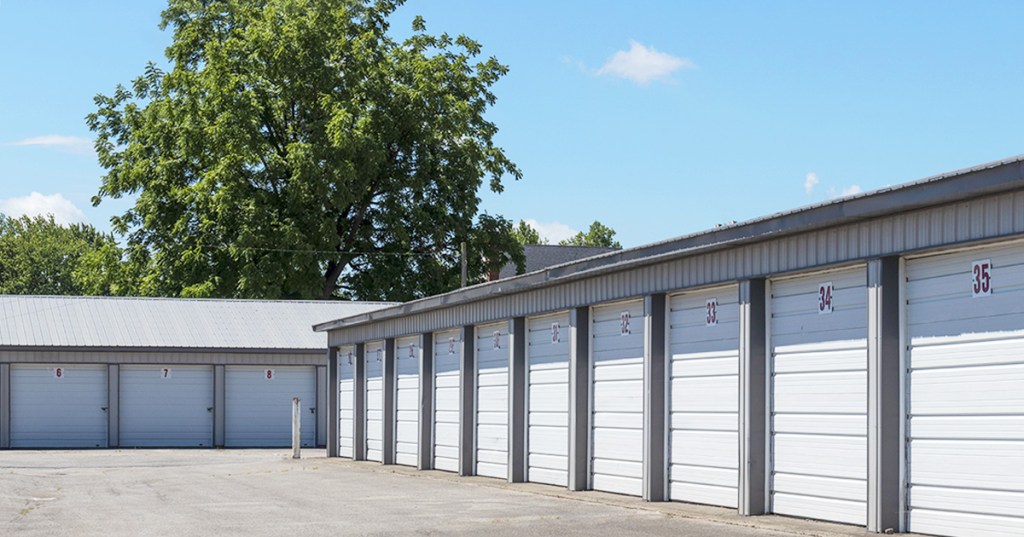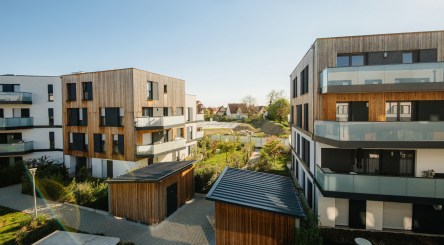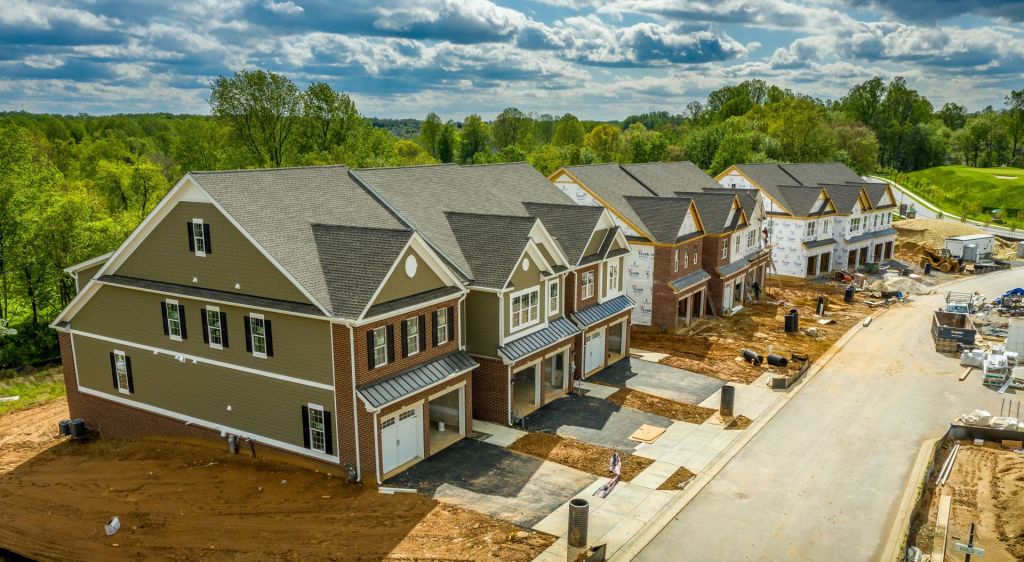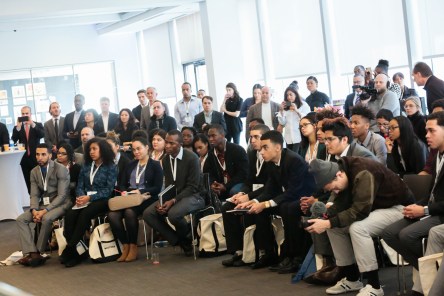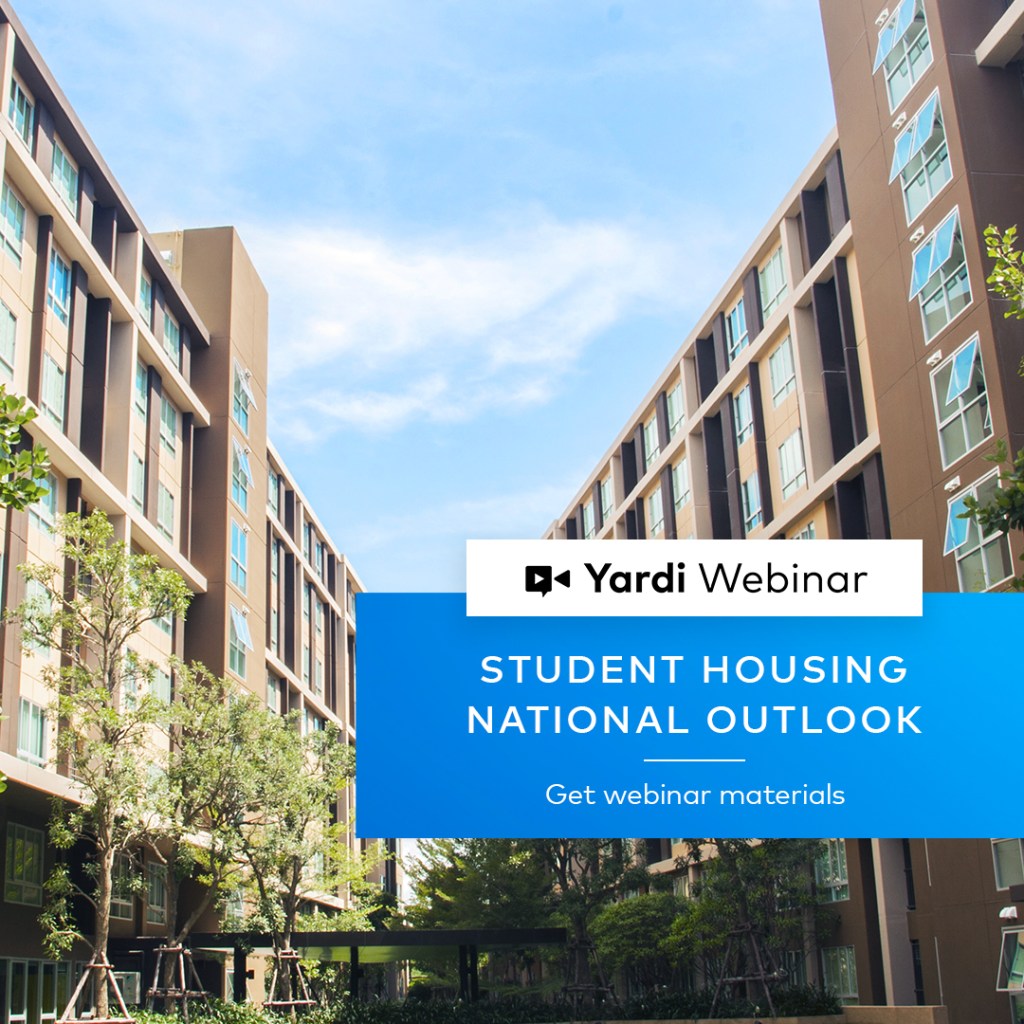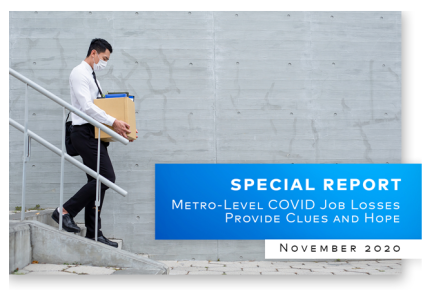The ongoing strength of the self storage industry continues to impress analysts from Yardi Matrix, the industry’s leading provider of real estate data. They presented a positive outlook for the sector in a webinar held Wednesday, Sept. 1. (View the recording.) Continued migration from all parts of the country is an ongoing positive for the industry. Street rates are up across the board, with all unit sizes, vintages and property ratings experiencing strong increases. Newer facilities and highly rated facilities, however, have seen their rates accelerate faster than competitors. “If people are moving anywhere, that’s a really good thing for self storage,” said Chris Nebenzahl, editorial director for Yardi Matrix. And Americans have been moving a lot recently – a Matrix estimate puts the amount of relocation at 6 years’ worth of moves condensed into a year and a half. But as the pandemic drags on, it has also been possible to pinpoint some of the additional reasons that demand for storage units, especially medium and large units, remains high. They include: As people transitioned to working from home or educating children at home, they used storage to remove furniture from their households to create space for those activities.Demand for socially distanced outdoor activities prompted the need for storage for vehicles like motorcycles, boats and ATVs. (Next year, Matrix will introduce reporting specifically on storage facilities that handle RVs and boats.)Both temporary and permanent moves prompted renters and homeowners to store items while relocating.Business use of storage units to aid with inventory management during a period of disrupted consumer behavior. Gateway markets, which were already seeing outbound migration pre-pandemic, saw the largest gaps between improved self storage performance and struggling performance of multifamily. Between March 2020 and July of 2021, street rates grew 24 percent in Chicago while multifamily rents edged up just one percent. And in Manhattan, street rates were up eight percent while multifamily rents dropped nearly nine percent. As street rates continue to rise month after month, investors and owners are wondering how long these gains can last. In the near term, they show no signs of abating. “The demand is there. We are seeing record growth rates. This is an opportunity for the self storage industry to make hay while the sun shines, but we think this is going to continue for another 18-24 months,” Nebenzahl said. Learn more about the self storage industry’s success in the latest Matrix National Self Storage...
Yardi at Apartmentalize
Get the Details
Chicago has reopened, and Apartmentalize powered by NAA will be there at McCormick Place from Aug. 31-Sept. 2 to bring forward-thinking multifamily operators from across the country and leading solution providers together. Yardi will return as a proud top tier partner, presenter and exhibitor. Read on for everything you need to know about this year’s event. See our innovative proptech Don’t miss the chance to connect with Yardi in person at Apartmentalize 2021. Come to booth #1001 to see our latest protech innovations. We’re excited to show you how our single connected solution will help you visualize performance, reduce expenses, automate interactions and enhance operations to increase your NOI. We will be featuring: REACH by RentCafe: Improve marketing ROI with advanced digital marketing services including SEO, PPC, social media, reputation management and performance analytics. RentCafe: Drive leases and improve retention for higher rental revenue with self-guided tours, a chatbot and smart home services. Yardi Elevate Suite: Combine deep operational data, market intelligence, revenue forecasting and prescriptive analytics to optimize asset performance and increase NOI. Introducing Yardi Breeze Premier: Our intuitive and powerful property management software is making its industry debut at the show. Boost performance with an easy-to-use, all-in-one marketing, management and accounting system. Reserve a private demo to see any or all of our proptech innovations that will take your business forward. Learn with us Yardi leaders will be participating in four educational sessions to share insights on hot industry topics and trends. Take advantage of these opportunities to deepen your industry knowledge and improve your operational strategies. Meet Gen Z: Understanding the Next Generation of Renters | Aug. 31, noon-12:45 p.m. Join Esther Bonardi, vice president at Yardi, as she leads a panel on Gen Z renter preferences with Garin Hamburger, senior director of national property marketing at Cushman & Wakefield, and Brooke Atsalis, marketing and training manager at The Management Group, LLC. Over 40,000 survey responses will help you get to know Gen Z through the data. Review shifting search trends, examine touring preferences and discover five tech must-haves. Learn how to adapt your property marketing strategy and shape your future success as we prepare to welcome a new generation home. Emerging Issues: Inflation and Its Effect on the Industry | Aug. 31, 1:15-2 p.m. NAA’s AVP of research, Paula Munger, joins industry experts, Jeff Adler of Yardi Matrix and Jay Parsons of RealPage, to discuss price trends, their impact on the economy and the industry, and what we can expect for the remainder of another very strange year. How will it affect the industry and how much sleep should you be losing over it? How Universities’ COVID-19 Decisions Impact the Student Housing Industry | Sept. 1, 3:45-4:30 p.m. Join Jeff Adler and Chris Nebenzahl of Yardi Matrix for a discussion on fall 2021 pre-leasing and how it compares to prior years. They’ll discuss rent growth in a post-COVID world, new development of purpose-built student housing, how universities have handled the pandemic from operational and housing perspectives and future plans for the industry. Myth Busting: Case Studies Debunking Affordable Housing Online Application Process | Sept. 1, 3:45-4:30 p.m. Geared towards affordable housing operators, Yardi vice president Christopher Voss joins Dawn Ford of Smart Apartment Solutions and Smart Moves, Phyllis Garcia of Ovation and Shay Dugan of TM Associates as they talk about the need for conducting business online and the perceived barriers considered unique to the affordable housing market. Pick up tools and possible solutions, such as low cost/no cost and easily accessible platforms that smash the myths that technology cannot exist in the application processes. See the complete Apartmentalize schedule for more information. Can’t make it this year? Not attending Apartmentalize 2021 but want to learn more about our solutions? Check out the Yardi Multifamily Suite, join a webinar or contact us with any...
Suburban Demand
Prompts Lending Boom
Investors have set their sights on suburban and tertiary markets. Lenders are responding favorably to the trend. While banks will continue to keep one foot planted in major metros, many are following their trusted relationships to less familiar terrain outside of city limits. Sleepy secondary markets are waking up The shift began as a trend prompted by the pandemic but has continued at a steady clip through the highs and lows of COVID-19. This is particularly true in cities where major employers have transitioned to remote and hybrid models. Many white collar industries such as technology, consulting and legal have adapted more flexible work conditions. With zero or fewer days required for office attendance, employees have been exploring their housing options. Blake Hering, principal with Gantry Inc explains, “As these remote operating models adopted by many office users have taken root and grown following last year’s social distancing mandates, a generational shift valuing the lower cost of living, higher quality of life, and larger footprint domiciles available in secondary markets has clearly fueled the beginning of a new, robust cycle for regional markets outside the MSA domain.” Employees are venturing further from their workplace hubs to secondary and tertiary markets where their money likely goes farther: lesser-known markets may offer more square footage for their money and more outdoor space, housing trends that were revitalized during the pandemic. Lending follows the leader The migration is particularly evident in MSA markets such as Seattle, Wash., and Portland, Ore. in the Pacific Northwest. Investors are following demand to smaller markets such as Bend, Salem and Tacoma. “This shift is now rewarding experienced sponsors in what have become prioritized markets by offering access to a host of new lending sources that once only reserved their allocations for operators...
Opportunity Zones
Risk or Potential?
Federal tax reform enacted in December 2017 reduced or eliminated capital gains taxes for investments directed toward multifamily, commercial and self storage real estate located in more than 8,700 low-income “opportunity zones.” This source of capital was expected to seed startups, accelerate business expansions, create jobs, improve housing options and revitalize built environments in areas where about 35 million Americans live. A Yardi Matrix white paper published in 2019 noted that the zones initially appealed to “a new base of largely untapped investors” and offered value-add opportunities in “new markets that were thought to be too small or risky as investment strategies.” Many policymakers touted opportunity zones as a way to create jobs and lift up underserved communities and minority-owned businesses. Critics assert that the program lacks transparency and mostly helps well-heeled investors and developers. A year-and-half since investors joined the program in earnest (many waited until final Treasury Dept. regulations were released in December 2019), has the opportunity zone initiative fulfilled its promise? Expert opinion is split. The White House Council of Economic Advisors, for example, reported in October 2020 that the program had attracted $75 billion in new investments to distressed American communities, $52 billion of which wouldn’t otherwise have entered the zones, and increased private property values within the designated areas by 1.1%. This infusion of capital represented “a powerful vehicle for bringing economic growth and job creation to the American communities that need them most,” holding the potential to “lift at least one million Americans out of poverty [and decrease] the poverty rate in opportunity zones by 11%,” U.S. Department of Housing and Urban Development official Denise Cleveland-Leggett said at the time. Michael Novogradac, managing partner of Novogradac, a San Francisco-based professional services organization, says the program “has seen notable...
Rents Rise Nationwide...
New report from Yardi Matrix
Multifamily asking rents jumped an average of 6.3% year-over-year in June, the largest leap ever recorded by Yardi Matrix, a leading industry data tracker. The national average apartment rent increased $23 last month to $1,482, another record, and single-family home rents were up 11% year-over-year. “These are the largest year-over-year and monthly increases in the history of our data set,” said Jeff Adler, vice president of Yardi Matrix. Analysts point to increased household savings and government stimulus funding as factors that have kept the multifamily industry stable during the pandemic period, and now able to rebound as the economy improves. The newly released data is an economic indicator of post-pandemic recovery across the U.S. The largest increases were documented in the lifestyle apartment sector. Renters are also now returning to many gateway markets that saw outbound migration for most of the last year. A supercharged housing market is also pricing out some potential buyers, leading residents to remain in apartments. “Rent growth will not be able to continue at these levels indefinitely, but conditions for above-average growth are likely to persist for months,” Adler said. The increases reflect growth in what landlords are asking for unleased apartments. Renters renewing leases may also be seeing increased rents, but likely at lower levels. Migration is pushing up rents in Southwest and Southeast metros like Phoenix (17.0%), Tampa and California’s Inland Empire (both 15.1%), Las Vegas (14.6%) and Atlanta (13.3%). These metros were lower cost compared to larger gateway metros. Get more insight on the historic report. Yardi Matrix offers the industry’s most comprehensive market intelligence tool for investment professionals, equity investors, lenders and property managers who underwrite and manage investments in commercial real estate. Yardi Matrix covers multifamily, student housing, industrial, office and self storage property...
Single-Family Rentals Heat Up
Hot Segment Gets Hotter
It’s been a great year for single-family rentals (SFR). Both the institutional single-family rental and build-to-suit segments have performed well despite the challenges of the pandemic. Influences on the single-family rental market One of the first notable booms in SFR followed the Great Recession. Families sought the benefits of homeownership, which include but aren’t limited to space, privacy and land. Simultaneously, they avoided a mortgage crisis and the responsibilities of home maintenance. Fast-forward a little more than a decade and SFR have surged in popularity again. Though there is no strong correlation between population density and viral spread, many Americans fled cities due to COVID-19. They relocated to less populated areas. Families that were priced out of homeownership as well as those who wanted to avoid its responsibilities rented homes in the suburbs and rural areas. The momentum of this trend continues as families savor the benefits of single-family living. Institutions are investing in single-family rentals SFR compose about one-third of the 46 million rental homes in the U.S. Traditionally, the majority of those rentals (nearly 98%) are operated by individuals and small businesses. We are currently witnessing a shift as investors with deeper pockets enter the market. Institutions are heavily investing in SFR. More than $10 billion are scheduled to bolster the segment in the next several years. Industry powerhouses such as Lennar Corp and Greystar Real Estate Partners are investing at least $1 billion each. Newer organizations, such as American Homes 4 Rent and NexMetro are also major players in the built-to-rent sector. Rather than sifting through rental homes scattered throughout communities, renters will be able to enter entire neighborhoods of built-to-rent houses. Such communities compose nearly 12% of current single-family construction. The latest data on single-family rentals Though the pandemic contributed to the growing success of the sector, SFR aren’t a pandemic-dependent trend. Since 2016, SFR rent growth has exceeded that of conventional multifamily rentals. Through mid-year 2021, SFR had improved to 6.4% nationally. Occupancy rates were at 94.3% nationwide. Though rents are performing well overall, secondary and tertiary markets have experienced the greatest growth in the last two years. There are currently more than 12,200 SFR units under construction in 50-plus unit communities. More than two-thirds are being constructed in secondary markets. The remaining are in tertiary markets. Yardi Matrix reports no SFR communities are under construction in gateway metros. The Southwestern region leads in construction with 4,896 units followed closely the Southeast with 3,978. Phoenix is home to the most existing SFR in communities with more than 50 units (about 6,000). It is also where most construction is taking place, a 2,500-unit slice of the 12,200 built nationwide. Jacksonville, Charlotte and Houston each have about 700 units under construction, with Atlanta expecting 544 units. The Midwest pipeline consists of 1,716 units and the West reports 1,522 units. The Northeast lags with 132 units. Single-family rentals demonstrate staying power SFR have been a growing segment of the rental market since 2009. The surge in built-to-rent homes indicate that investors are committed to the benefits that they are receiving. They have the ability to control their brand and the renter experience from start to finish. They can also focus on a large number of holdings in fewer locations. Analysts propose that investors will enjoy improved liquidity, since there are more potential market participants with single-family construction. Download the complete Yardi Matrix single-family rental...
Single Family Rentals...
The latest frontier
Is there a market for renters who want it all? Privacy, outdoor living space, a manicured lawn and financial flexibility are available to renters of single-family homes. Research reveals that interest in single family rentals has been growing since the Great Recession. The pandemic further ignited demand, as demonstrated by a surge in the construction of single-family rentals. As the market develops, specialized technology is necessary for smart growth. Industry powerhouses set their sights on single-family rentals In mid-2020, the first wave of institutional buyers made their mark on the industry. During Q1 2021, they continued the trend by purchasing nearly 55,000 homes, according to Redfin data. Built-to-rent single family homes are also taking off. New York-based Trepp real estate analytics firm reports a 66% increase in single-family homes built to rent. Both homebuilders and apartment companies are entering the market. Builders such as Lennar Corp., the largest homebuilder in the nation by revenue, and multifamily behemoth Greystar Real Estate Partners are investing in single-family houses. Mike Clow, executive director at Greystar, aims to increase investment in the division by a noteworthy 1,566.66% percent by 2026. Operator Invitation Homes announced that it will spend $1 billion in single-family home acquisition in 2021, per an interview with Business Insider. While major players are pumping major dollars into the sector, small landlords still own the majority of single-family rentals. Only about 6% of new homes are built-to-rent. Single-family rental data by Yardi Matrix The demand for single-family rentals is reflected in the strength of rents and occupancy. Yardi Matrix reporting now includes insights into built-to-rent single-family communities. Data is compiled from more than 90,000 units in 700 communities nationwide. Single-family rentals (SFR) thrived during the pandemic. The industry recorded a powerful 7.3% year-over-year (YoY) rent...
Recovery Gains
National Multifamily Report
As the U.S. economy continues to show recovery gains, multifamily housing follows suite. Several factors including prevalent industries, vaccination rates and employment create a distinction between markets with rapid growth and lagging gains. Need-to-know data, quick and easy Multifamily rents increased by 2.5% year-over-year (YoY) in May. This nearly reflects rent growth rates of March 2020, before the development of pandemic trends. For the second consecutive month, all top 30 metros showed positive month-over-month (MoM) rent growth. An impressive 90% had MoM gains of 0.5% or more.Rents grew $12 in May to $1,428. That’s the largest one-month increase in Matrix history. The 0.8% MoM growth rate was the largest since June 2015.Rents increased nationally by 0.8% in May. Of our top 30 metros, 22 demonstrated positive YoY rent growth this month. Run, walk, and crawl: metros demonstrate growth at different rates Some rents grow at a sprint. YoY rent growth reached double digits in the Inland Empire for the first time in recorded history. Rent growth in the Inland Empire clocked in at 10.2% followed by at Phoenix 9.6% and Sacramento at 8.3%. Gateway markets have found a comfortable stride. Miami reports a respectable 6.0% growth, the strongest in the region. Others are crawling or have yet to budge, though all signs point to improvements soon. Chicago with 0.0% growth and Los Angeles at -0.1% are still better positioned than San Jose (-9.0%), New York (-8.8%) and San Francisco (-6.7%). Introducing single family rental data Matrix reporting now includes single-family rents within built-to-rent communities. Data is compiled from more than 90,000 units in 700 communities nationwide. Single-family rentals (SFR) thrived during the pandemic. The industry recorded a powerful 7.3% YoY rent growth as of May. This reflects an overall rent increase of about $14...
National Outlook
For Industrial & Office
A new webinar outlined the continued success of the industrial real estate sector and ever-evolving picture for the office market. The May 13 presentation was hosted by Yardi Matrix and CommercialEdge. Insightful detail from the presentation is available on both CRE market segments as well as regional breakdowns. Find the full recording at yardimatrix.com Strong fundamentals continue for industrial Yardi Matrix vice president Jeff Adler had nothing but positives to share about the state of the U.S. industrial sector. Durable fundamentals for both supply and demand indicate that industrial will be a strong investment well into the future. “I’m really not concerned that this is some kind of bubble,” Adler noted, as the available supply and new development of industrial properties can barely keep up with current demand. As a result, rents are performing well, especially in coastal markets, and vacancy rates across the nation are low. E-commerce continues to be a major contributor to industrial’s success, but the backbone of the industry is general goods distribution and small-scale manufacturing. E-commerce won’t have the same double digit increase it did in 2020 due to pandemic activity constraints, but demand is expected to remain consistent. Consumers learned to rely on direct ordering during the pandemic, Adler noted, and can save time by continuing such shopping habits. Major ports and large population centers lead the industrial rent growth list, with California’s Inland Empire in the No. 1 spot and Sacramento at No. 2. But smaller markets have the highest percentages of industrial supply under construction, led by Amarillo, Little Rock and Albuquerque. Nationally, the amount of new industrial space in the pipeline is not expected to disrupt rent gains. Adler anticipates industrial has about three years of runway for its continued strong performance. Yardi Matrix data...
Multifamily Picks Up
According to Yardi Matrix
The multifamily market is rebounding from the pandemic at a rapid clip, and gateway markets are now seeing positive performance indicators for the first time in many months. The latest Yardi Matrix Multifamily National Report has much good news for owners and investors, including a 1.6 percent year-over-year rent bump. “That is the largest increase that we have seen since the beginning of the pandemic,” said Matrix analysts. Overall rents increased by $10 in April to $1,417. The last time overall rents increased by that amount in a month was June 2015. It was also the largest year-over-year jump since March 2020. Out of the top 30 markets Matrix reported on, 24 had month-over-month rent growth greater than 0.5%. Of particular significance were the gains in gateway markets. Miami leads the gateway markets with 0.8% rent growth on a trailing 3-month basis. All other gateways had positive trailing 3-month rent growth, with Chicago (0.5%) and Boston (0.4%) showing strong gains. Washington, D.C. (0.2%), New York, San Francisco and Seattle (all 0.1%) are further back in the recovery process. “We expect the gains in these markets to strengthen as we head into the summer,” states the report. Find more good news and in-depth analysis for multifamily from Yardi Matrix. Yardi Matrix offers the industry’s most comprehensive market intelligence tool for investment professionals, equity investors, lenders and property managers who underwrite and manage investments in commercial real estate. Yardi Matrix covers multifamily, student housing, industrial, office and self storage property types. Email [email protected], call (480) 663-1149 or visit yardimatrix.com to learn...
Apartment Investment
NMHC Research Forum Recap
Jeff Adler, vice president of Yardi Matrix, was recently featured as a guest panelist on an NMHC virtual forum. The April 20 focused on apartment investment, trends and economic factors affecting the industry. Adler appeared alongside Jim Costello, senior vice president at Real Capital Analytics, and Suzanne Mulvee, senior vice president of research and strategy at GID. The conversation was moderated by Dave Borsos, vice president of capital markets at NMHC. Markets like Portland, Oregon have seen an influx of residents as rising single family home sales over the last year. All three industry experts were bullish on the state of the multifamily industry, which is already well on its way to recovery from the impact of the COVID-19 pandemic. “As it relates to multifamily, it is game on,” said Adler. “(Investors) are out there buying and rents are up. There are pockets of weakness in the urban gateway but if you look south and west, there are a lot of people bidding with a lot of cheap (capital). There are a lot of people moving out of office investments and into industrial and multifamily.” The economy and inflation risk With many Americans flush with cash, both from saving during the pandemic and stimulus funds from the federal government, spending is rampant and economic growth is expected to be around 6.5 percent for 2021, Mulvee noted. But with those conditions comes a concern about potential inflation. “We know we are going to see a period of six months or so of inflationary pressures,” Adler said. “But we hope that in six to nine months, there will be enough deflationary counter pressures that it won’t get out of hand. That in my mind is the bigger issue.” Costello, who writes extensively on market conditions, tempered...
Multifamily Outlook
From Yardi Matrix
The economy is recovering quicky after severe impacts from pandemic shutdowns over the last year. That was the top line good news from Thursday’s webinar on the multifamily industry, presented by Jeff Adler, vice president of Yardi Matrix. The recovery timeline is expected to be around 18 months. “The economy is heating up as the job market strengthens,” said Adler. “A recovery in gross domestic product is clearly under way. I would liken this to a shot out of a cannon.” Inflation is a short-term concern, however. Hear the full analysis and insight in the webinar recording. Rents are on the rise across the country, and that’s a positive indicator for the industry and the economy at large. Multifamily rents increased by 0.6% on a year-over-year basis in March, with the national average rising by $6 to $1,407. Out of 134 markets surveyed, 114 had flat or positive YoY rent growth. Impacts vary, however, across states and cities. Gateway markets like Boston, Chicago, Miami, New York, San Francisco and Washington D.C. appear to have now hit bottom in rents and are positioned for gradual recovery. Leading the way in March’s rent increases were affordable cities and suburbs in the West, with the Inland Empire (8.3%), Sacramento (7.3%) and Phoenix (6.9%) leading national tallies in year-over-year rent growth. “It will take several years for gateway markets to recover, under the best of circumstances,” said Adler. “There has been just as much movement within metro areas at about a 30-40 mile radius. People are moving out of the urban core and into surrounding suburban areas. That’s a meaningful amount that will make coming back to the office problematic, but they aren’t detached from the metro area entirely.” Single family rentals and the build-to-rent sector have also...
NAA Digital Studio
Achieve Stronger NOI in 2021
Do you want to emerge from 2021 with a more efficient, agile and profitable organization? Discover insights to help you reach your goals during the National Apartment Association (NAA) Digital Studio Series! Stronger NOI in 2021 The April NAA Digital Studio, presented by Yardi, is a half-day event including deep dive and interactive sessions, industry panels, networking and more. This month’s theme is “Stronger NOI in 2021: Where do we grow from here?” Experts from leading multifamily companies across the country will discuss the many ways in which COVID-19 has impacted the real estate industry and, more specifically, apartment management. Each session features unique programming that tackles common industry challenges. Through the sessions, you can: Explore market changes and projected financial impacts to help you plan smarter in 2021 and beyond. Gain insights from multifamily leaders who will share new performance metrics they’re using to change the way they do business. Discover ways to improve net operating income beyond rent increases. Featured speakers include guests from Luma Residential, Bell Partners, BH Management Services, Cirrus and more. Industry professionals focused on operations, marketing, technology and related roles will walk away with practical, actionable items to strengthen your organization. Work + play The event kicks off with keynote speaker Jeff Adler, vice president of Yardi Matrix, offering an engaging look at the latest multifamily data. Examine changes in rent growth, occupancy, retention and renter preferences over the last 12 months. Learn how new demographic patterns have affected top and bottom markets. Attendees will also see rent and occupancy forecasts for a variety of property groups. Then, stick around for additional sessions that connect the market update to real-life experiences and plans to protect NOI going forward. End the day with a relaxing musical interlude. Leslie and...
Smooth Sailing for Self Storage
For next 18-24 months
As Americans continue to move about the country in the aftermath of the COVID-19 pandemic, they’re often downsizing, temporarily relocating, or electing not to take all of their possessions along with them. The exodus of renters from high priced gateway cities has been beneficial for the self storage market, and Yardi Matrix vice president Jeff Adler is carefully confident that strong demand for storage units will continue for the next 18 to 24 months. “I’m cautiously optimistic, but wouldn’t say wildly optimistic, about the sector near term,” Adler said during a Self Storage National Outlook webinar presented on March 24. The webinar also included an overview of the national economy, potential for inflation, employment trends and other factors. It’s available to view online. For the next few months, renters may be moving back to cities that they left a year ago to resume in-office employment or making final decisions about whether to stay in a new city they tried out while escaping an urban lifestyle in 2020. Those moves will likely impact storage positively. Although vacancy across the country’s largest office markets continues to inch upwards compared to Q1 2020, increases in office sale and rent prices show investors have not lost any confidence in the strength of both traditional and up-and-coming markets. For example, the latest national office market report released by CommercialEdge found that, despite pandemic challenges, Nashville saw a year-over-year increase of nearly 6% in office lease rates, which rested at $31.06 per square foot — coming up closely behind San Diego office space, which averaged $39.44 per square foot, following a modest increase of 0.8% compared to February 2020. Self storage demand could be further bolstered if there is a second wave of moves out of higher-cost real estate markets, Adler shared. Such moves will be contingent on employment trends as the country recovers from the year-long pandemic. So far, migration is flowing from California to states like Colorado, Texas and Arizona, and out of New York to states like Florida and North Carolina. Utah and Idaho are also experiencing a high volume of new residents. “As long as there is movement of people, storage tends to do quite well. Continuing moves would keep the demand for storage high,” Adler said. But at some point, pandemic-influenced demand is expected to subside. National street rates for 10×10 non-climate-controlled (NON-CC) units increased by 2.6% compared to February 2020, and rates for 10×10 climate-controlled (CC) units grew by 3.1% over last year. While street rates nationwide saw substantial growth year-over-year, rates for both unit types remained flat month-over-month. Along with the industrial sector, self storage is a bright spot for real estate investors. Focused on short-term returns, however, they are mainly electing to purchase existing properties rather than sink time into ground-up development. Deal velocity picked up at the end of 2020 and 2021 is expected to be a record year for self storage transactions. “Relative to industrial, which is very pricey, and other asset classes, self storage as an investment class is very attractive and that’s driving a lot of institutional investor interest,” Adler said. Consistent street rate performance and ease of management are both positives for investors. The only downside for some markets is large supply pipelines, which could push down prices as they come online. Nationwide, Yardi Matrix tracks a total of 2,237 self storage properties in various stages of development: 597 under construction, 1,201 planned and 439 prospective properties. The national new-supply pipeline as a percent of existing stock increased 0.1% month-over-month in February, and the share of existing projects in planning or under construction stages accounted for 8.4% of existing inventory. Matrix also maintains operational profiles for 26,534 completed self storage facilities across the United States, bringing the total data set to...
Project Destined
Yardi Matrix Partners
Project Destined is an organization focused on providing education and access to the commercial real estate industry for minority students. Programs are targeted towards high school and college students, with the goal of introducing real estate ownership to people who may not have previously studied or worked in the commercial real estate industry. Yardi Matrix has provided 10 complimentary education licenses to Project Destined for use in their curriculum and internship programs. Students will have full access to Yardi Matrix’ industry-leading data and analysis to use when researching, underwriting and presenting potential deals to their teachers, industry mentors and competition judges. Chris Nebenzahl, editorial director for Yardi Matrix, has been actively involved with Project Destined. “I have been volunteering to teach the market research segment of the curriculum and offer guidance for how students can use Yardi Matrix with the projects they are working on,” said Nebenzahl. “I focus on our data at the property, submarket and market level. The students are tasked with creating an investor presentation and pitching their deal to a panel of industry judges. Through the process, they need to provide valuation models, market research, forecasts, and cash flow models, all of which can be developed and leveraged by using Yardi Matrix data.” Nebenzahl began working with Project Destined in early 2020 and has lectured virtually at each session held by the organization since then. Project Destined was started by entrepreneur Cedric Bobo to expand opportunities for minority students within the commercial real estate field and to encourage his students to become owners and community stakeholders in the cities where they live. Project Destined started 5 years ago and has grown significantly to include students in many major markets around the country. Bobo, who grew up in Memphis, was fascinated...
Student Housing Slows Down
Sector Outlook Remains Positive
Yardi Matrix vice president Jeff Adler presented a look both forward and back for the student housing sector in a webinar held Wednesday, March 3. (Find the presentation materials and recording here.) Despite the challenges of the pandemic over the last year, the sector has held up relatively well. Rents are still increasing – but just slightly. Year-over-year rent growth was 1.3%, with Class B assets taking a larger hit than Class A or C housing. Adler remains very positive on the student housing space, even though preleasing is currently behind its usual pace for Fall 2021. “We do expect the 2021 term to have a surge in enrollment and preleasing activity, but it will probably come late, in April and May, as the vaccine situation clarifies,” he said. That was just one of many insightful takeaways from the presentation. Yardi Matrix produces a quarterly student housing report that summarizes leasing, rent rate, transactions and other trends. The student housing data set includes over 2,000 universities and colleges nationwide, including the top 200 investment grade universities across all major collegiate conferences. Known as the “Yardi 200,” it includes all Power 5 conferences as well as Carnegie R1 and R2 universities. Schools that have fared best with housing over the last year have been those that are not urban or in states with strict COVID restrictions in place, Adler said. Overall, national university enrollment is down 2.5% this year from a year ago. Currently, preleasing of student housing for Fall 2021 is trending four percent below where it was last year at this time. Preleasing for Fall 2020 ended up five percent behind 2019 numbers. “Large, first tier institutions have done the best, and the top performers are those that have been in states and localities that were open for business (throughout COVID),” said Adler. Universities that have preleasing off to a good start for the upcoming fall term were major public universities in remote areas and some universities near smaller downtowns. That includes schools like Case Western University, the University of New Hampshire-Main Campus and University of Pittsburgh-Pittsburgh campus, which are leading the way as top preleasing performers for Fall 2021. Schools that are falling behind on preleasing include the University of Illinois at Chicago, Brigham Young University and the University of California at Santa Barbara, which are all lagging far from their normal preleasing numbers. As a result of the pandemic, housing providers are seeing higher demand for studios, single bedrooms and bedrooms with their own personal bathroom, Adler said. “Those without bedroom/bathroom parity are struggling (to lease). This may be an issue that continues, where you would have to have very significant discounts to overcome people’s desire not to share a bathroom.” The desire for personal space will also impact on-campus student dorms, which may have to rethink double and triple occupancy situations due to parent and student concerns. “I’m bullish about the whole sector, because dorm capacity just doesn’t work,” Adler said. It also doesn’t seem to matter whether schools are offering fully in-person learning, a hybrid model or all virtual classes. The school simply needs to be open for business in order for student housing demand to remain strong. “Our data showed that they wanted to get out of the house (in 2020) and they did.” Development trends in student housing reflect what life will look like post-pandemic. High performance Wi-Fi, always a must, has become even more important. Apps that allow students to submit maintenance or service requests are trending, as are outdoor/open spaces where students can gather in person. And touchless features, like keycards for building entry or elevator operation, will be more prevalent. Development of new student housing stock is primarily focused in the south and southwestern U.S. and has not been deterred by the pandemic. Investment opportunity in the sector remains strong. Highlights include: Global Student Accommodation Group (GSA) made its...
Industrial Outlook
Is looking good, says CommercialEdge
It’s a rosy outlook for the newest real estate sector to be featured in a CommercialEdge monthly report. In 2020, the industrial sector was considered the top performer of all major real estate sectors. Industrial rents averaged $6.38 per square foot in December 2020, a 4.8% increase over the last 12 months, according to the first-ever CommercialEdge Industrial Monthly. All of the top 20 markets covered in the report saw at least some measure of growth in average rent over the last year. The ongoing industrial report will cover data on rents, occupancy, supply and transactions, as well as key economic indicators. “Rent growth across the board bucks the trend of other commercial real estate asset classes. Both multifamily and office have a substantial share of markets with falling rents and increasing vacancies, something not seen among the top 20 industrial markets,” note the analysts. Demand for e-commerce infrastructure and a huge boost in online sales during the pandemic have been a boon for industrial assets. Today, e-commerce accounts for nearly one-fifth of core retail sales. In 2020, a record 228.4 million square feet of industrial space was delivered, the most new space completed this century. That milestone is a further indicator of the health of industrial real estate. These projects were well underway before COVID-19 induced a demand surge for industrial space, signifying that the industry was already on the upswing before 2020 put things into overdrive. Find the full CommercialEdge Industrial Monthly for...
Multifamily Outlook
From Yardi Matrix
After a year ravaged by disease, division, job losses and economic hardship, expectations for the multifamily industry in 2021 are the subject of a new Yardi Matrix outlook. “While there does appear to be light at the end of the tunnel, it will take some months to get most of the country vaccinated and get businesses operating as normal,” states the report. Job growth has been mostly positive since the summer, but the economy remains nearly 10 million jobs off its peak. Millions of renters continue to struggle to make monthly payments. The $900 billion stimulus package passed at the end of 2020 provided some relief, especially the $25 billion renter assistance, $25 billion for Housing and Urban Development (HUD) programs and $300 per week supplemental unemployment. “However, another package is likely to be needed in 2021 to keep many families and property owners afloat,” the report’s authors opine. Nationally, rent growth fell only slightly in 2020, but there was a huge variation among metros. Rents and occupancy levels fell sharply in high-cost gateway markets, as renters left crowded and expensive coastal centers. More affordable markets in the Sun Belt, Southwest, Midwest and Mid-Atlantic saw modest rent growth. In 2021, the expectation is that gateway markets will continue to struggle, and the industry will have to deal with weak rent collections, eviction bans, forbearance requests, lobbying for renter aid and new federal mortgage oversight protocols. Despite the challenges, capital flow remains strong. Sales activity dropped about 35% in 2020, but investors are still looking to buy apartments. Agency lenders have had their allocations clipped slightly, but debt availability is also strong. Construction has slowed, with less than 300,000 deliveries in 2020. With more than 750,000 units under construction now, new supply should stay in...
Status of Storage
Yardi Matrix report
Confidence in self storage remains high as the sector demonstrates ongoing strong street rate performance despite COVID-19’s continued impact across the U.S., reports the latest Yardi Matrix National Self Storage Monthly report. National street rates for standard 10×10 non-climate-controlled (NON CC) units increased 1.7% last month compared to November 2019. While year-over-year street rates nationwide for 10×10 climate-controlled (CC) units did not increase, the flat performance reflects an improvement over the first nine months of 2020. From October to November, national street rates for 10×10 NON CC units also saw an increase of 0.9%, while nationwide rates for similar-size CC units remained unchanged. Annual street rate performance was negative in only about 19% of the top markets tracked by Yardi Matrix for 10×10 NON CC units in November. Rates for this unit type were hit the hardest in Minneapolis, which saw a 3.5% decrease year-over-year. Experts caution that despite several months of rosy reports, there still could be challenges ahead. “While self storage has established itself as a strong performer in difficult market conditions, it could face a tough slog ahead as another round of COVID-related lockdowns and restrictions emerges this winter,” states the report. Nationwide, Yardi Matrix tracks a total of 2,136 self storage properties in various stages of development—comprising 590 under construction, 1,134 planned and 412 prospective properties. The national new-supply pipeline as a percent of existing inventory increased by a minor 0.1% month-over-month in November, and the share of existing properties in various stages of development accounts for 8.3% of existing inventory. Yardi Matrix also maintains operational profiles for 26,351 completed self storage facilities across the United States, bringing the total data set to 28,487. Read all the highlights for self storage in the latest National Self Storage Monthly...
Employment Impacts
New Yardi Matrix report
The COVID-19 pandemic has been inconsistent in the way it has affected the U.S. employment market, creating a wide disparity between metro and job segments. This is the main conclusion of the latest special employment report from Yardi Matrix. Leisure and hospitality was by far the biggest employment sector loser, with 3.8 million jobs lost. In contrast, only 1.8% of the jobs in financial services have been lost since the start of the pandemic. However, the overall impact varied greatly depending on the city. Metros with the best job performance include those with relatively small leisure and hospitality industries and those that have lost relatively few jobs in the segment (Indianapolis, for example, lost only 6.5%). One outlier, Austin, has added 8,200 professional and business services jobs and 7,300 financial services jobs since February. While the size of a metro’s leisure and hospitality segment is a key in the extent of job losses, a more significant factor is how thoroughly the metro shut down to stop the spread of COVID. Few of the top 10 metros in the percentage of jobs lost since February are among the leaders in leisure and hospitality jobs, but all are at or above the average proportion of jobs lost in the segment. New York City, for example, has a relatively small leisure and hospitality segment (9.8% of all jobs), but a whopping 42.3% of those jobs disappeared. “The data does show hope for the future for the gateway metros that have been hard hit, because the core industries in those metros, such as finance and professional services, remain viable,” states the report. “Once a vaccine is available and people feel safe going back to entertainment venues, restaurants and the like, gateway cities (like New York, San Francisco, Boston...
Opposite Outlooks
For Industrial and Office sectors
It’s a tale of two outlooks for the industrial and office real estate sectors, reported the experts from Yardi Matrix and CommercialEdge in a commercial real estate webinar presented on Nov. 11. As the end of 2020 nears, each market has a different trajectory. For owners and investors in the office sector, the full impact of the pandemic and its impact on the way employees work, especially in the knowledge and technology sectors, has yet to be unveiled. Major office properties tend to operate on long leases, so while rent remittance has been generally solid this year, as leases come to term in 2021 things could change. The big question, said Yardi Matrix vice president Jeff Adler, is what use of office space looks like in the future. One thing 2020 has taught us is that it likely doesn’t look like the old model of spending five days a week in a cubicle. “There is a re-evaluation of ‘what is the purpose of space?’ Was the purpose of that space that people got things done there? Or was it a culture purpose? If it was simply to do a task, it’s become clear that task can likely be done at home. How space is used, why space exists and why you need it in the first place is going to be reimagined,” Adler said. “What kind of office footprint do you actually need to achieve the business goals that you have?” The answers to those questions will determine the floorplans and lease terms of offices post-pandemic. Also at play: where they’re located (public transit use is still dramatically decreased) and how many workers will come to the office on any given day. Right now, going back to a 5-day office work week seems highly...
Multifamily Movement
Yardi Matrix updates industry trends
The number of Americans who have moved since February 2020 wasn’t unusual compared to typical U.S. mobility trends, but there has been a distinct shift in where they are relocating, according to the latest Yardi Matrix multifamily webinar. In brief, big urban cities like New York, Chicago, San Francisco and Miami are out, while second tier markets and tech hubs like Austin, Kansas City, Sacramento and Boise are in. “What we really have seen is a movement of people that is different from what we have seen in the past,” said Jeff Adler, vice president of Yardi Matrix, who delivered the analysis. A webinar on the commercial real estate market with valuable insight for that sector will take place on Wednesday, Nov. 11. You can register here. The Nov. 4 multifamily session, which is now available to view on demand, summarized the trendlines for the apartment market nationwide. It has been relatively resilient despite the economic fallout caused by the COVID-19 pandemic. For example, in the month of October, 94.6 percent of apartment households had paid rent as of Oct. 17, according to NMHC’s Rent Payment Tracker. However, small owners and managers of less than 50 units are suffering. These owners typically hold small balance loans, or SBLs. “Because SBLs are typically used to finance apartments with less than 100 units, each resident that has trouble paying rent has a more significant impact on the property’s cash flow,” stated the Matrix summary. The bulk of the 16 million Americans who have moved since February, though, are working from home and seeking a relocation situation that will be advantageous during the remaining months of the pandemic. They’re seeking out apartments or single-family homes where they have more space and eschewing the walkable urban lifestyle that...
Student Housing’s Strength
Sector shows resiliency, says Yardi Matrix
Despite massive disruption to in-person learning protocols, demand for off-campus, purpose-built student housing remains strong, according to a webinar and a new bulletin from Yardi Matrix. “College students don’t want to live at home. And their parents seem quite amenable, if financial circumstances allow it, for them not to live at home,” said Jeff Adler, vice president of Yardi Matrix, during the webinar. “There’s been a tremendous amount of noise around the sector, but as it relates to the financial performance of off-campus student housing, it is largely unaffected.” The one key factor is that college or university the students are attending must be offering classes in some capacity, even if they are all online. Need for greater social distance between students in on-campus dormitories have been another helpful nudge. “As long as the school is open somehow, for the dedicated off-campus student housing inventory, (the education format) doesn’t matter,” Adler said. “The off-campus student housing industry has shown itself to be really resilient.” Development pipelines also remain strong, with only two planned projects nationwide falling off the radar in the last quarter. Enrollment trends have favored public universities rather than private schools, indicating that students may be looking for more affordable education alternatives given current economic uncertainty. And off-campus housing options provide a more continuous housing option than on-campus dorms, which are more likely to be subject to closures or status changes. Though college enrollment from international students is down due to travel restrictions, those spots in off-campus housing seem to thus far have been backfilled by American students. One caveat is that these are students whose parents’ economic fortunes have likely not been disrupted by the pandemic. And even if no vaccine is available in spring 2021 as expected, purpose-built student housing is expected to continue to do well. “Even if everything goes horribly wrong (with vaccine development), the fact that this year was as good as it was indicates that as long as the school is open in some fashion, it’s a non-event for the off-campus student housing sector,” Adler said. For the 200 colleges and universities the Matrix team analyzed, preleasing of purpose-built student housing was just 3 percent behind that of 2019. “While demand has been volatile on a university-by-university basis, the willingness and desire for people to congregate near their school will likely help the student housing sector steer through these uncertain times,” states the analysis. Preview new technology for student housing providers at the NMHC/InterFace Student Housing Conference, a virtual event taking place Oct. 19-22. Visit the virtual booth to see how RentCafe Student and Yardi Matrix Student will graduate your leasing and management...
Surviving + Thriving
Self Storage Sector Stays Resilient
During every Yardi Matrix webinar, vice president and presenter Jeff Adler shares the big picture of current economic conditions and conundrums – also known as the Yardi Matrix House View. Here’s how the view is looking from the Matrix vantage point these days: “We had a deep recession. We’re in the middle of a recovery. That recovery is likely to be choppy,” summarized Adler to close out Thursday’s Matrix update on the self storage sector. A recording of the presentation is now available, and you can view that here. But for those invested or interested in the self storage market, the seas are not looking quite so rough. Of all commercial real estate sectors, storage had a brief negative impact from COVID-19’s rise in the U.S., and then quickly recovered. “Storage is actually doing quite well,” said Chris Nebenzahl, editorial director for Yardi Matrix. “The demand for storage has been consistent and is stronger than some of the other asset classes in commercial real estate.” Key factors for the sector’s resiliency include: Relocations and population migration. Americans are leaving congested big cities like New York and Los Angeles for second-tier markets where they have more space. Residential volatility. For example, college students have faced ever-changing mandates about whether they would resume classes in person and online, prompting quick moves that often involve a need for storage. Economic hardship. Job losses for millions of Americans are contributing to relocations and downsizing. According to a Pew Research Center Survey, roughly one in five U.S. adults say they have either changed their residence due to the pandemic or know someone who did. The proof of sustained demand for storage is in the street rates, particularly for the non-climate-controlled category. Month-over-month rates reported for August showed that national...
End of Urbanization?
New attention for suburbs
For years, 24-hour and 18-hour cities, and the live-work-play concept, have been mantras in commercial real estate. Suddenly, however, cities are facing a pandemic-driven exodus. Is this a temporary blip or the start of a long-term trend? COVID-19’s impact has been particularly deep in major metropolitan areas such as New York City, Los Angeles, Chicago and San Francisco office space, which have also seen sharp drops in apartment occupancy rates and rents as the city centers are largely shut down and residents shelter elsewhere. In Manhattan, for example, office buildings that were closed for months remain mostly empty upon re-opening, as employers avoid putting workers at risk and people avoid public spaces. Midtown streets that are typically teeming with tourists are nearly empty as Broadway and other entertainment venues remain shut. New York City’s story is being played out in city centers across the country. Not only do urban areas temporarily lack the jobs and cultural institutions that drew people there, but the crowds and closeness are suddenly an element to be feared rather than fascinate. Few if any saw this coming, as growth has coalesced in cities in recent years. The United Nations has forecast that 75 percent of the global population would live in cities by 2050, doubling their size, and the U.S. seemed to be headed in that direction. A recent study of the largest 30 U.S. metros by the George Washington University School of Business and Smart Growth America in conjunction with Yardi Matrix found that walkable neighborhoods encompassing office, housing, retail and entertainment grew faster and produced higher absorption and rent growth over the last decade than counterparts without that combination. During that time, 70 percent of the jobs created were in the top 50 U.S. metros. Corporations have been...

